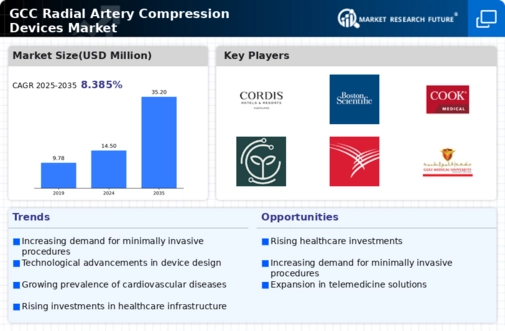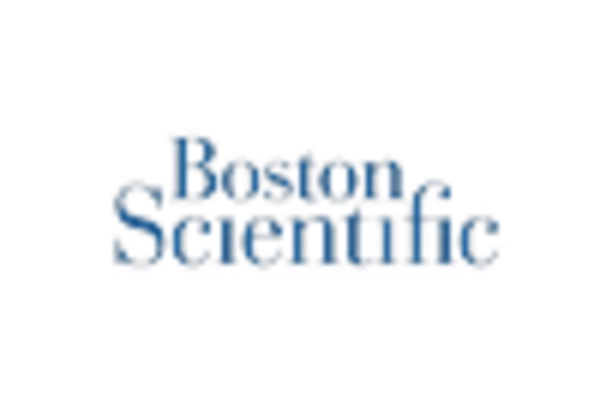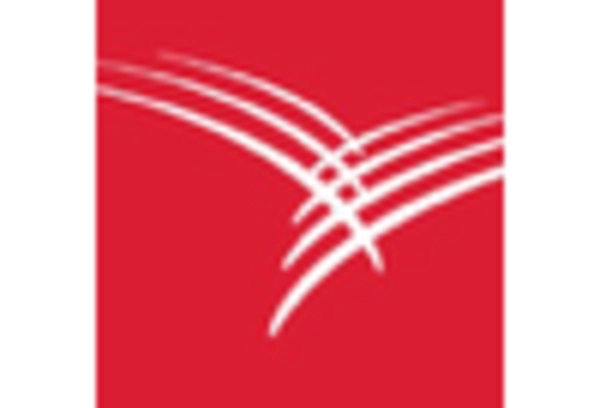Expansion of Healthcare Facilities
The expansion of healthcare facilities across the GCC is a significant driver for the radial artery-compression-devices market. As new hospitals and specialized clinics are established, the demand for advanced medical equipment, including compression devices, is expected to rise. This growth in healthcare infrastructure is aligned with the region's vision to enhance healthcare services and accessibility. The establishment of state-of-the-art medical centers is likely to create opportunities for the adoption of innovative technologies. Market analysts project that the radial artery-compression-devices market could experience a growth rate of around 18% as these facilities seek to equip themselves with the latest medical devices to improve patient care.
Government Initiatives and Funding
Government initiatives aimed at improving healthcare infrastructure in the GCC are playing a crucial role in the radial artery-compression-devices market. Increased funding for healthcare projects and the establishment of specialized medical centers are expected to drive demand for advanced medical devices. Governments are prioritizing investments in healthcare technology to enhance patient care and outcomes. This focus on modernization is likely to create a favorable environment for the adoption of radial artery-compression devices. Furthermore, public-private partnerships may emerge, facilitating the development and distribution of these devices. As a result, the market could witness a growth trajectory of around 10% over the next few years, driven by supportive policies and funding allocations.
Growing Awareness of Patient Safety
The rising awareness of patient safety and quality of care is significantly impacting the radial artery-compression-devices market. Healthcare providers in the GCC are increasingly prioritizing the implementation of devices that minimize complications and enhance patient recovery. This shift is driven by both regulatory requirements and patient expectations for safer medical procedures. As hospitals strive to improve their safety records, the demand for reliable and effective compression devices is likely to increase. The emphasis on reducing post-procedural complications may lead to a market growth rate of approximately 12% in the coming years. Additionally, educational campaigns aimed at healthcare professionals regarding the benefits of these devices could further bolster market expansion.
Rising Cardiovascular Disease Incidence
The increasing prevalence of cardiovascular diseases in the GCC region is a primary driver for the radial artery-compression-devices market. As healthcare providers seek effective solutions for managing these conditions, the demand for advanced medical devices rises. According to recent health statistics, cardiovascular diseases account for a significant portion of mortality rates in the GCC, prompting healthcare systems to invest in innovative technologies. This trend is likely to continue, as the population ages and lifestyle-related health issues become more prominent. Consequently, the radial artery-compression-devices market is expected to experience substantial growth, with projections indicating a potential increase in market value by over 20% in the next five years. The focus on improving patient outcomes and reducing recovery times further fuels this demand.
Technological Innovations in Medical Devices
Technological advancements in medical devices are significantly influencing the radial artery-compression-devices market. Innovations such as automated compression systems and smart monitoring technologies enhance the efficiency and effectiveness of these devices. The integration of digital health solutions, including mobile applications for real-time monitoring, is becoming increasingly prevalent. This shift towards more sophisticated technology not only improves patient care but also streamlines clinical workflows. As hospitals and clinics in the GCC adopt these advanced solutions, the market is likely to expand. The introduction of new products that offer enhanced safety features and user-friendly designs could potentially increase market penetration, with estimates suggesting a growth rate of approximately 15% annually over the next few years.

















Leave a Comment